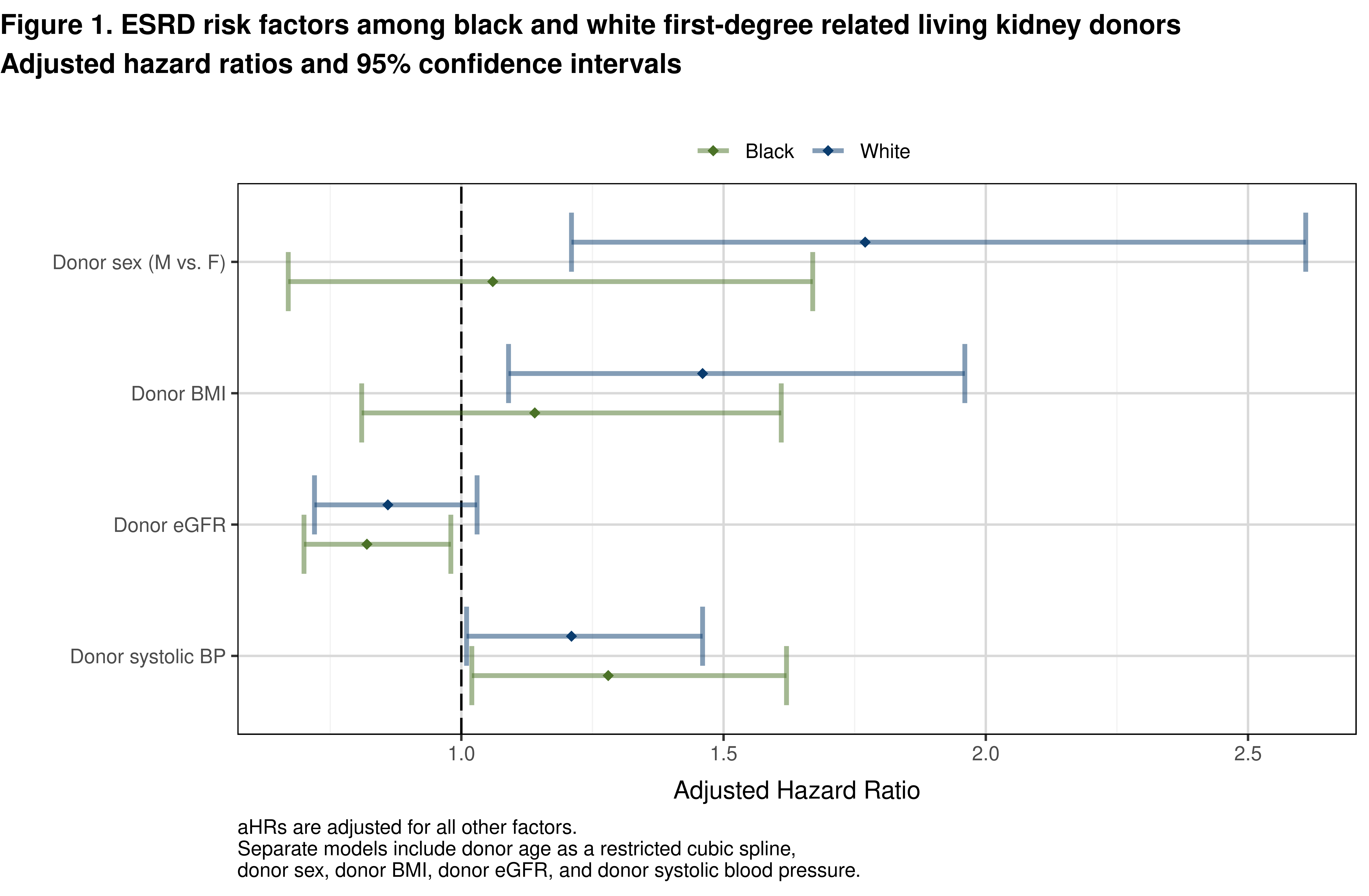ESRD Risk Prediction for Black vs. White Related Living Kidney Donors
1Research, UNOS, Richmond, VA, 2Chief Medical Officer, UNOS, Richmond, VA
Meeting: 2020 American Transplant Congress
Abstract number: C-077
Keywords: African-American, Donation, Kidney, Outcome
Session Information
Session Name: Poster Session C: Kidney Living Donor: Long Term Outcomes
Session Type: Poster Session
Date: Saturday, May 30, 2020
Session Time: 3:15pm-4:00pm
 Presentation Time: 3:30pm-4:00pm
Presentation Time: 3:30pm-4:00pm
Location: Virtual
*Purpose: We studied 25-year risk of post-donation ESRD in black (n=10,214) and white (n=45,700) first-degree related living kidney donors (RLKDs) who donated in the US during 1994-2018, ascertaining ESRD with OPTN and CMS data.
*Methods: We ran separate multivariable Cox regression models by race and found the effects of donor factors on risk of ESRD varied across race.
*Results: Eighty three black and 115 white first-degree RLKDs developed ESRD through 12/31/18 (Table 1). White RLKDs had increased risk of ESRD if they were older, male, or had higher pre-donation BMI or systolic blood pressure (Figure 1). Black RLKDs were at increased ESRD risk if they had higher BP or lower eGFR; effects for BMI and sex among black RLKDs were directionally consistent with white donors, but not statistically significant. Older age was associated with lower risk for black RLKDs. Contrary to previous findings, donor age – which we allowed to be non-linear – was not associated with ESRD risk for donors younger than the median age in either group, suggesting previous findings were driven by assuming linearity (Figure 2). The relative importance of donor characteristics varied between the two groups: all studied donor factors were associated with ESRD risk for white RLKDs; for black RLKDs, age, BP, and eGFR were stronger predictors of post-donation ESRD than donor sex or BMI – likely because of ApoL1-related risk.
*Conclusions: Previous research revealed a race by age interaction for ESRD risk. This study provides a refined understanding of this interaction effect, while also suggesting the possibility of two new interactions – race by sex and race by BMI – that warrant further study.
| Black Donors | White Donors | |||
| Characteristics | ESRD (N = 83) | No ESRD (N = 10131) | ESRD (N = 115) | No ESRD (N = 45585) |
| Time observed (years), median (IQR) | 13.7 (9.5-19.0) | 13.9 (8.5-18.4) | 13.7 (10.2-18.2) | 14.0 (8.2-18.8) |
| Donor age (years) | 34.0 (28.0-39.5) | 35.0 (28.0-43.0) | 44.0 (34.0-51.0) | 41.0 (33.0-49.0) |
| Donor sex (male) | 41 (49.4%) | 4438 (43.8%) | 69 (60%) | 19327 (42.4%) |
| Donor BMI (kg/m2) | 28.7 (25.9-30.8) | 27.6 (24.5-30.9) | 29.0 (25.7-31.6) | 26.5 (23.6-29.6) |
| Donor eGFR (mL/min/1.73m2) | 100.2 (84.1-109.6) | 107.6 (92.7-123.1) | 87.8 (73.2-102.3) | 95.1 (82.4-107.0) |
| Donor systolic blood pressure | 129.0 (118.0-135.5) | 121.0 (113.0-130.0) | 130.0 (119.5-136.5) | 120.0 (112.0-130.0) |
| Full sibling of recipient | 40 (48.2%) | 4361 (43%) | 59 (51.3%) | 22530 (49.4%) |
| Child of recipient | 32 (38.6%) | 4162 (41.1%) | 18 (15.7%) | 12735 (27.9%) |
| Parent of recipient | 11 (13.3%) | 1608 (15.9%) | 38 (33%) | 10320 (22.6%) |
To cite this abstract in AMA style:
Wainright J, Robinson A, Wilk A, Klassen D, Cherikh W, Cartwright L, Stewart D. ESRD Risk Prediction for Black vs. White Related Living Kidney Donors [abstract]. Am J Transplant. 2020; 20 (suppl 3). https://atcmeetingabstracts.com/abstract/esrd-risk-prediction-for-black-vs-white-related-living-kidney-donors/. Accessed December 26, 2025.« Back to 2020 American Transplant Congress


